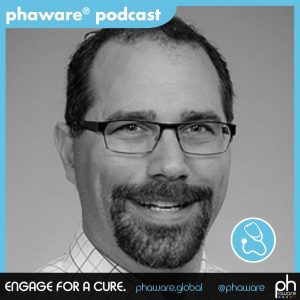Phaware Podcast: Peter Leary, MD, Part 1 — Embolism

This podcast series, created and produced by phaware, is being offered as a regular guest feature on Pulmonary Hypertension News to bring the voices and life experiences of PH patients, family members, caregivers, healthcare specialists, and others to our readers. You may listen to the podcast directly, or read it via the transcript that runs below.
I’m Aware That I’m Rare: Peter Leary, MD
The phaware® interview (Episode 93)
Peter Leary, MD, is a specialist in pulmonary and critical care medicine who cares for patients with pulmonary hypertension. Leary is focused on clinical care and research for patients with pulmonary vascular disease. In Part 1 of 2, Leary discusses Pulmonary Embolism and CTEPH.
I’m Peter Leary, I’m from the University of Washington Pulmonary Vascular Disease Program.
Today we’re going to chat a little bit about pulmonary embolism and chronic thromboembolic pulmonary hypertension.
Pulmonary embolism is a pretty common thing. For a variety of different reasons, people can get blood clots from anything for sitting too long a period of time and having blood kind of coagulate. That blood clot will then go back up through the veins, through the heart, and out into the lungs. If it goes into the lungs, that’s what we call pulmonary embolism, which is just a fancy way of saying blood clot in the lungs. Some people have genetic predispositions to having blood clots. Some medications and things like that can make you more likely to have a blood clot as well.
The way that I think about blood clots in the lungs is I think about acute and chronic, which is another way of saying blood clots that just happened right in that minute, and blood clots that have been kind of sitting in the lung for a longer period of time.
Most people, right when they get a blood clot, they’ll feel short of breath. Maybe they’ll feel their heart racing. Some people feel lightheaded or dizzy. Some people will have some chest pain, especially when they take a deep breath. When you talk to an emergency room doctor, or you’re talking to your primary care doctor, this is what most people are going to say a blood clot feels like. This is an acute pulmonary embolism or acute blood clot. Those tend to be recognized pretty well. Most of the time I think (they) are being picked up on.
Now, on the other side of the fence, is a chronic blood clot. This is a series of blood clots that have developed in the lung over the course of time. About half of these people may have had an acute blood clot. They may have had that shortness of breath, the chest pain that all came up, and they have a history of that. A lot of these people don’t. What do they feel?
They feel more just like pulmonary hypertension. If I went into downtown Seattle and closed off every third street, you could get congestion that backs up all the way to the neighboring city. The same thing happens with blood clots in the lungs. If you get blood clots that are closing down the pipes through the lungs, if you don’t feel them right when they happen, you will feel them over time because you get congestion that backs up. You get shortness of breath, you get swelling in your legs. You can get fullness in your abdomen. That’s what we call chronic thromboembolic pulmonary hypertension.
Chronic thromboembolic pulmonary hypertension I think is frequently missed, and I think as awareness is picking up people are catching more of it. But I think that a lot is still being missed. The estimates are that of everyone who has a blood clot in their lungs, about 3% of those don’t go away. 3% of those acute blood clots become chronic thromboemboli in the lungs.
So, a patient who has a blood clot in their lungs, and six months later after treatment says, “Hey, I still feel short of breath,” there’s a chance that that blood clot did not go away with blood thinners the way that we expected it to. Until recently, we would never repeat and go looking for that.
To add onto that, there are a couple of different ways of looking for blood clots. Historically, we looked with a test called a V/Q scan. As technology advanced, we developed CT pulmonary angiology.
CT pulmonary angiology is actually not very good at finding chronic blood clots. It is great at finding acute blood clots. It’ll find them just as well as a V/Q scan does. It may miss up to half of chronic blood clots. Unfortunately, as people have become more and more married to CT pulmonary angiography, which is the newer technology. Fewer and fewer V/Q scans are being used. Really people have to know what they’re looking for. Know that this V/Q scan is probably the better test in order to find it. In order to find chronic thromboemboli.
The shorter answer to that long one the explanation is I think we’re catching almost all of the acute PEs, but we’re probably missing a lot of the chronic pulmonary emboli.
For the vast majority of people when you get a blood clot, you get started on blood thinners. The blood thinners prevent your body from making new clot. Then your body breaks down the blood clot that was already there. In the vast majority of people, your body breaks down that blood clot. 97% of people your body will break down that blood clot.
For reasons that we don’t fully understand, some people’s body doesn’t break down that blood clot. These are the people who go on and have chronic thromboembolic disease. I think there’s a couple different ways that you can think about this. There is some disagreement about the right way. Because 97% of people with a blood clot if they go on blood thinners for three to six months, their blood clot goes away. That’s probably good enough for the vast majority of people. Most people should feel pretty confident that their blood clot has gone away.
Now, I think some people would say, everyone should get a V/Q scan six months after they’ve get treated for a blood clot to see if they’ve got any chronic blood clot. I don’t know whether we necessarily need to do that. What I do know is if you’ve had a blood clot, and six months later you’re still feeling short of breath… or your heart is racing… or you don’t feel like you were before you had that blood clot, then the best thing to do is to take a look and see whether it’s gone. The best way to take a look and see whether it’s gone is with a V/Q scan, which is the older test that’s nonetheless better for finding chronic blood clots.
I’m Peter Leary and I am aware that I’m rare.
EVERYBODY HAS A STORY. WHAT’S YOURS?
Phaware global association wants to share your pulmonary hypertension story with their engaged global audience. Whether you are a patient, caregiver, or medical professional, they are enlisting PH community members from around the world. Visit www.phawarepodcast.libsyn.com/contact to share your story and to be considered for a future episode. Never miss an episode with the phaware® podcast app. Learn more about pulmonary hypertension at www.phaware.global. #phaware
***
Note: Pulmonary Hypertension News is strictly a news and information website about the disease. It does not provide medical advice, diagnosis, or treatment. This content is not intended to be a substitute for professional medical advice, diagnosis, or treatment. Always seek the advice of your physician or other qualified health provider with any questions you may have regarding a medical condition. Never disregard professional medical advice or delay in seeking it because of something you have read on this website. The opinions expressed in this column are not those of Pulmonary Hypertension News or its parent company, Bionews Services, and are intended to spark discussion about issues pertaining to pulmonary hypertension.










Leave a comment
Fill in the required fields to post. Your email address will not be published.